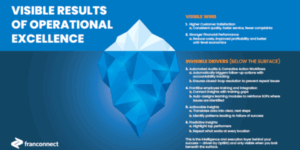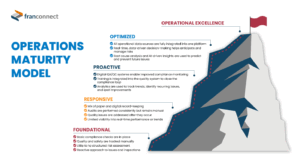Maintaining consistency across every location is one of the biggest challenges growing brands face and the foundation for long-term success. As brands expand, keeping every location aligned becomes both the hardest and most essential part of growth.
That’s where operational excellence comes in.
Operational excellence is the discipline of building a business that runs reliably, efficiently, and profitably no matter how many locations, employees, or moving parts you manage. It works by creating systems that keep standards high, teams aligned, and performance predictable, even as you scale.
It’s not a buzzword. Operational excellence is the framework that makes it possible.
It’s a repeatable and scalable strategy for delivering reliable performance, strengthened teams, and measurable growth no matter how large your footprint gets.

What Is Operational Excellence in Franchise Growth?
Operational excellence is the continuous pursuit of improved efficiency, reliability, and effectiveness across all facets of the business.
For multi-location brands, it means going beyond compliance to create systems and behaviors that drive quality, efficiency, and growth at scale.
And when done right, the results are clear:
- 20–30% decrease in revenue lost to operational inefficiencies
- 25% improvement in compliance scores
- 18–20% increase in unit-level economics
At its core, operational excellence turns growth from a guessing game into a repeatable formula. When you create systems that blend visibility, accountability, and agility, every level of your organization becomes capable of improving performance and protecting profitability, no matter how fast you grow.
With the right structure and visibility, multi-location brands can scale with confidence, knowing that every location delivers the same quality, efficiency, and experience.
Why Operational Excellence Matters
To be brief, customer expectations have changed.
According to the survey, 73% of Americans are likely to abandon a brand after just one poor customer service experience. With nearly three-quarters of consumers now willing to abandon a brand when customer service is poor, patience for poor customer service by consumers is running perilously thin.
Inconsistent service, missed standards, or disjointed processes can quickly erode trust in your brand. Operational excellence gives you the structure and visibility to prevent these bad experiences so every location delivers an experience your customers can count on.
With the right systems in place, brands can:
- Deliver consistent experiences at every location
- Improve efficiency and reduce manual work
- Empower frontline teams to take action
- Scale faster without losing control
When every location runs on the same proven playbook, operational chaos turns into clarity. The right systems give leaders real-time insight, frontline teams the confidence to act, and customers the consistent experience that keeps them coming back.
Common Roadblocks on the Path to Excellence
Even the best brands can get stuck when their systems don’t evolve with their growth.
Disconnected Systems
Training, quality, and performance tools often live in different platforms, or worse, spreadsheets and emails. Without a unified system, it’s nearly impossible to get a real-time view of operations.
Limited Visibility Across Locations
If you’re relying on customer complaints or monthly P&Ls to spot issues, you’re already behind. Without real-time insights, leaders can’t coach or course-correct effectively.
Inconsistent Onboarding and Training
Without standardized onboarding and continuous learning, new hires get mixed messages, or no training at all, leading to uneven performance and higher turnover.
The Four Pillars of Operational Excellence
Operational excellence doesn’t come from a single process. It’s built on four interconnected pillars that drive consistency, accountability, and performance across every location.
Pillar #1: Standardize Core Operations
Consistency starts with structure.
Establish repeatable processes and clear expectations across every location using standardized checklists, SOPs, audits, and workflows.
When every team follows the same playbook, execution improves and so does the customer experience.
What it looks like:
- Prebuilt digital audits and task lists
- Centralized SOPs and operational documentation
- Clear, repeatable processes for recurring activities
Pillar #2: Enable and Train Teams
Operational excellence depends on your people.
Give teams the knowledge, tools, and support they need to perform. Role-based onboarding, microlearning, and ongoing coaching ensure every team member is confident and consistent from day one.
What it looks like:
- Digital onboarding tied to roles
- Targeted microlearning modules
- Field coaching and performance tracking
Pillar #3: Act on Data
Dashboards, location scorecards, and tools like Frannie AI help you identify what’s working and what’s not. Instead of waiting for issues to appear in reviews or revenue reports, operators can catch problems early and act in real time.
What it looks like:
- Real-time performance dashboards
- Automated alerts and follow-ups
- Predictive insights to guide decision-making
Pillar #4: Close the Loop
Turn insights into action.
Operational excellence relies on identifying problems and creating processes to solve them. By connecting audits, training, and performance data, you create a continuous improvement loop that strengthens your culture and results.
What it looks like:
- Evaluation results triggering targeted training
- Trackable action plans and resolution workflows
- A coaching-first culture, not a policing one
Together, these four pillars create the structure every growing brand needs to scale with confidence. When they work together, teams know what’s expected, leaders see what’s happening in real time, and every location delivers the same dependable results.
The Journey Toward Operational Excellence
Every brand is somewhere on the journey toward operational excellence, and that journey rarely follows a straight line. It begins with foundational processes, often manual and inconsistent, where visibility is limited and leaders are forced to react to issues rather than anticipate them.
As brands mature, they begin to introduce structure: digital checklists, standardized tools, and early efforts to unify operations. This responsive stage brings progress, but teams often still rely on lagging indicators and siloed systems that make it difficult to see the full picture.
Momentum builds in the proactive stage, where systems start to integrate, data becomes central to decision-making, and coaching replaces correction as the dominant management style. Here, leaders begin to spot issues before they affect customers and operations shift from reactive to strategic.

The final stage which we like to call, ‘optimized operations,’ is where operational excellence becomes a competitive advantage. Automation, AI, and predictive analytics work in the background to identify trends, streamline workflows, and continuously elevate performance. Quality, compliance, and growth move in lockstep, creating a self-sustaining culture of improvement.
Most brands today fall somewhere between the foundational and proactive stages, working to connect fragmented tools, introduce visibility, and create consistency across locations. The goal isn’t overnight transformation, but a continuous, data-driven progress built on systems that adapt as you scale.
What’s visible to customers are the results: consistent experiences, faster service, and stronger performance. But the real power lies beneath the surface in the invisible drivers that make those results possible. Automated workflows, connected training systems, and real-time insights turn operational data into measurable growth. These capabilities are what transform good brands into great ones and they’re the foundation of the FranConnect platform.
Ready to Build Your Own Path to Excellence?
As a Chief Operating Officer, you play a crucial role in shaping how your brand delivers, grows, and scales. On top of overseeing daily operations, our role includes driving efficiency, aligning processes with strategic goals, and ensuring the brand thrives in a constantly evolving industry.
To help, we’ve created a free resource ‘The Operational Excellence Playbook for COOs.’
Inside, you’ll learn how leading brands use operational excellence to:
- Drive efficiency and accountability across every location
- Empower frontline execution
- Align daily operations with long-term strategy
Download this free playbook today to learn how to create systems that scale, empower teams to perform, and turn operational excellence into a lasting competitive advantage.










 Ian Walsh
Ian Walsh












